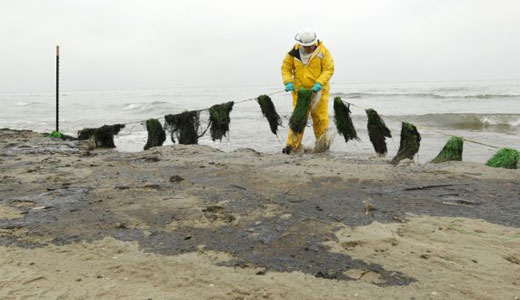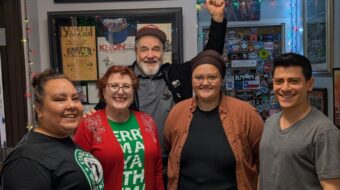
The oil spill that occurred in the Houston Ship Channel on Mar. 23 is having quite a devastating ripple effect on the environment. The disaster, which began when a barge and vessel collided and spilled 170,000 gallons of oil, is now traveling west along the coast of Texas due to heavy currents, complicating cleanup efforts and leaving many migrating birds poisoned or dead.
Some of the oil that plagued the channel is breaking up into troublesome patches and headed in different directions – partly toward the Gulf of Mexico, but more recently, in the other direction down the coast, with crude that could show up hundreds of miles from the spill site. Strong winds have worsened matters, causing the oil to spread across a wider distance.
“You literally have to have a flat sea to vaccuum or remove that oil from the water,” said Scott Smith, chief scientist of Water Defense, a clean water organization founded by actor and environmental activist Mark Ruffalo. “The wind creates the chop and then you can’t get the oil out quickly with these older technologies. Then you take the risk of spreading, like it’s doing now.”
The Environmental Defense Fund added, “This spill is significant. There have already been reports of oil traveling more broadly [from the channel] into Galveston Bay. Galveston Bay is one of America’s greatest estuaries and an important home to Texas seafood providers and recreational fishermen. This spill not only threatens birds and other large animals residing in the bay, but also important seafood species like shrimp, blue crab, menhaden, and oysters. It could also impact populations of popular recreational fish, like red drum and speckled sea trout. Investigation and long-term monitoring within the footprint of this spill is necessary.”
The sensitive bird sanctuary nearby, Bolivar Flats, is, as experts feared, already being affected by the aftermath of this spill. Though signs of oil onshore there are being called “minimal,” birds have been arriving covered in oil. Those birds only have a 50/50 chance of survival, experts say, because they cannot help but ingest the oil when preening their feathers. Numerous fowl have already died, including 37 in Galveston Bay. Others are particularly at risk, as they are in the midst of migrating season.
Now, a second wildlife refuge is at risk. Matagorda Island, and its surrounding Matagorda Bay, are home to a variety of unique, rare, and endangered birds, as well as deer and alligators, but as of Mar. 26, oil slick was found as close as 15 miles away from the island. Workers are scrambling to put up a protective boom around the sensitive areas of the island coast, but some fear it might be a case of “too little, too late”.
“Any impact made by oil there will be very high, because it’s a largely undisturbed area,” said Jorge Brenner, a marine scientist with the Texas Nature Conservancy. “That makes it a really bad target.”
The wellbeing of some oiled birds is out of experts’ hands in Texas because they have already flown to other areas. Oil-covered loons and other migratory birds were found Mar. 28 in parts of Minnesota, some with poor health. Dozens of birds within six different species have already required treatment.
Meanwhile, experts expect the oil to continue to spread farther away from Houston Ship Channel. “Our prediction is that oil is going to be caught up in the coastal current and be carried further west,” said Doug Helton, incident operations coordinator with the National Oceanic and Atmospheric Administration. “It is a combination of winds and currents. Particularly, wind speed and wind direction have a big factor on the behavior of the oil. Our predictions on this so far have been pretty accurate.”
In other words, the worst may be yet to come.
Photo: A worker sets up an oil absorbent skirt on a beach in Galveston, Texas. Jennifer Reynolds/AP









